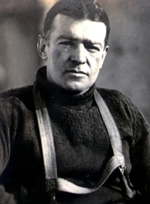 |
| (http://www.bbc.co.uk/history/historic_figures/shackleton_ernest.shtml) |
Dark waves ambush the glistening iceberg, and with a deafening roar and crash, an ice chunk detaches from the mother piece and floats off into the cold and restless distance. The South Pole is a dangerous, freezing cold, and unpredictable place. But the South Pole is also where legendary heroes arise. Born on February 15th, 1874 in Kildare, Ireland, Ernest Henry Shackleton, leader of the Endurance expedition, is the most well-known Antarctic explorer to date. Although Shackleton had visited the Antarctic region several times before and after his famed Endurance journey, the Endurance is what he is most famous for. When Shackleton had to leave almost all his crew on a tiny, deserted island, the time he spent thereafter proved to the world that he had immense leadership and could persevere through anything. Not one of his crew members died, reinforcing the fact that Shackleton’s leadership and perseverance in the face of adversity makes him a truly inspiring hero.
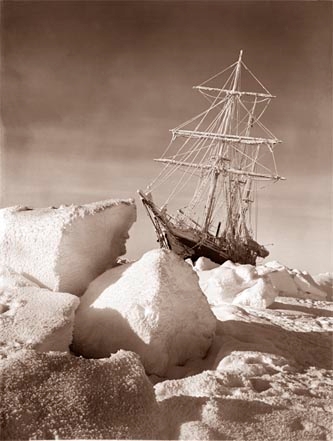 |
| The Endurance after it became trapped in an ice floe (http://www.greenmuseum.org/generic_content.php?ct_id=260) |
During the Endurance expedition, Ernest Shackleton exhibited preeminent leadership to his crew amidst the harsh Antarctic environment. At every point in time, Shackleton made crucial decisions that would’ve eventually saved his crew from a dark, cold death.
For example, when the Endurance became trapped in an ice floe, Shackleton commanded the men in an exhausting effort to free their ship. Day and night, the men worked, the ice still hadn’t allowed for passing of the ship. The water pressure within the ship rose all throughout the day, until the decks broke, “the keel was ripped out, the water poured in. At five PM, Shackleton gave the order to abandon ship. He hoisted the blue ensign…”(Alexander 89). Shackleton was not only struggling to save the ship, but supervising and making important decisions as well, such as the decision to abandon ship. He was aware that if he let the ship flood, all pressure would settle on him, and he would have to find another way to reach the South Pole. But this didn’t faze Shackleton, ready to tackle every dilemma the expedition encountered. After the crew made it to Elephant Island, Shackleton selected the expedition’s best men to sail to a “Remote whaling station in South Georgia” to receive help. After reaching land, they made a “ten-day overland trip before reaching the station” (“Ernest Henry Shackleton, Sir”). While the crew remained on “desolate” Elephant Island, Shackleton was forced to choose a few men to sail eight hundred and fifty miles across the treacherous Antarctic waters to find help. He could’ve just chosen to wait along with the expedition, and expect someone to rescue them, but he took a big step by leading a quest to South Georgia. His leadership during the voyage to South Georgia ultimately saved the crew’s lives, but this “quest” was definitely a time-consuming one. “Two days after arriving at the whaling station, Shackleton set out on the Southern Sky to retrieve the men stranded on Elephant Island .However, after ten days, he returned because the ice in his direction was too thick. His next two tries also failed to reach the island… he asked the Chilean government for help” (Fine 35-36). Shackleton chose not to stay in the comfort of dry land with plentiful food, hot water, and shelter. Instead, singlehandedly, he attempted to navigate the seas to rescue his crew. Instead of using his leadership to guide others, Shackleton took initiative to save his men, after already failing to do so three times. The astounding leadership this man had allowed him to make the decisions that brought him one step closer to saving his men. His trait of leadership, combined with his perseverance, made Ernest Shackleton one of the greatest heroes alive.
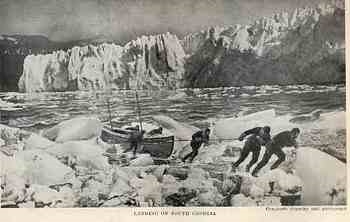 |
| The James Caird landing at South Georgia (http://www.ask.com/wiki/James_Caird_(boat)) |
Shackleton’s unwavering perseverance in the face of major adversity proved to the world that nothing is impossible if you never give up. The Endurance voyage was strenuous to say the least. However, when it seemed like everything was going wrong and quitting was the only option, Shackleton defied the odds and obliterated any obstacles audacious enough to stand in his way. “The boat [the James Caird] had a low piece of canvas that sheltered the men from the constant splashing of waves. Still, water poured in from every direction, soaking the crew to the skin. None of the men could sit upright under the canvas. They had to lie down while they ate. Reindeer hair [that filled their] now-rotting sleeping bags sometimes choked the men while they slept. Worse, the only remaining fresh water was now filled with reindeer hair and salty ocean water that had spilled over the side. If the men didn’t find land soon, they would die” (Fine 29). As the crew came within close proximity of death, Shackleton withstood it. Nothing was ever too much of a burden for him. He was so determined to rescue his crew that he endured the tainted water, soaking wet clothes, and the freezing weather on his ten-day boat journey, barely brushing past death in the process. When the crew finally reached shore, however, another perilous travel awaited Shackleton. “The condition of the boat, shortage of drinking water and deteriorating health of one of the men forced the group to land on the island's uninhabited western shore. Ships and relief lay on the opposite side. On May 19, only ten days after landing and with their feet still numb from frostbite, Shackleton, Worsley and Crean set out on foot for the whaling stations, a journey of twenty-two miles across the mountainous interior of an island that had never been mapped. Their sole equipment was a carpenter's adze, ninety feet of rope, and a compass, while screws from the Caird provided traction for their worn shoes. The men carried food for three days: any longer they knew would be beyond their limits” (“The Expedition: The Crossing.”). Shackleton and his men knew that they were being shoved way out of their comfort zone. Even with one man deathly ill, Shackleton was determined to persevere through the situation to find a way to make all the ends meet. He suffered the painful effects of frostbite while walking twenty-two miles to receive assistance. Given the limited supplies, and condition and morale of the men, it was far too simple for Shackleton to call it quits and give up. But he did not take the easy route; his ability to persevere allowed him to withstand the arduous adventure. But when the crew was trapped in a twenty-two-foot boat in the middle of a barren ocean, right in the heart of a hurricane, Shackleton’s perseverance really shined through. “By break of day, the James Caird was trapped in a perilously heavy cross sea and enormous swell that was driving them towards the coast. Rain, hail, sleet, and snow hammered down, and by noon the gale had become a full-fledged hurricane whipping a mountainous sea into foam and obscuring every trace of land…. With each blow, her bow planks opened, and water squirted in; caulked with oil plaints and seal blood…they steered towards what appeared to be a propitious gap…five times they bore up and tacked, and on the last attempt the Caird sailed through the gap and into the mouth of the bay” (Alexander 151-52). Shackleton’s enormous amount of perseverance allowed the crew members aboard James Caird to resist a hurricane! His leadership and perseverance combined urged the men to not give up, even if it meant trying to sail through a small gap 5 times. Without the inspiring, never-give-up attitude of Shackleton, powered by his will to save his expedition, the James Caird would’ve met its fate at the rocky cliffs of a nearby island.
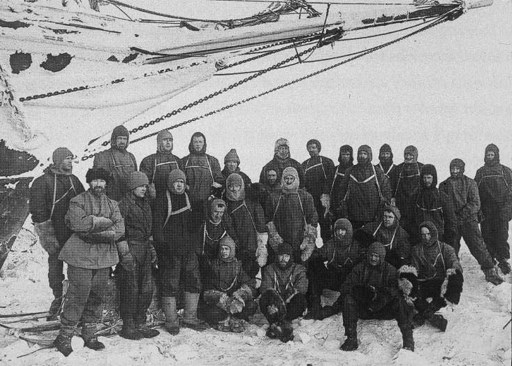 |
| The Endurance crew Shackleton worked so hard to save his crew (http://www.findingtruthmatters.org/articles/shackleton/index.html) |
It takes a true leader and perseverant person –a hero – to save an entire crew of men, captives to the harsh Antarctic world. Ernest Shackleton proved himself a hero when he accomplished this, powerfully leading the expedition while surviving a merciless journey that lasted about two years. A high point in the Endurance expedition was definitely the journey of the James Caird. “Together, the six men had maintained a ship routine, a structure of command, a schedule of watches. They had been mindful of their seamanship under the most severe circumstances a sailor would ever face. They had not merely endured, they had exhibited the grace of expertise under ungodly pressure…They would later learn that a 500ton steamer had foundered with all hands in the same hurricane they had just weathered… the voyage of the James Caird would be ranked as one of the greatest boat journeys ever accomplished” (Alexander 153). Under Shackleton’s watchful eye and fueled by his perseverant attitude, all the James Caird crew members are recognized as having manned one of the “greatest boat journeys ever accomplished.” The story of Shackleton’s leadership and perseverance has inspired the world. And without him, where would this expedition have been? The James Caird would be lost at sea without a leader, the men would have long ago given up and the boat would have been destroyed by the hurricane. “Shackleton thought that the next great conquest was to traverse the Antarctic continent from coast to coast via the pole and with this end, so set forth the Endurance expedition of 1914-17. Although this expedition was possibly the least successful Antarctic Expedition at the time in terms of achieving the goal - through no fault of planning or foresight - it became one of the greatest adventure stories of all time and enshrined Shackleton's reputation almost in legend (“The Expedition: The Crossing”). From the beginning, it’s plain to see that Shackleton was inspired to explore Antarctica coast to coast, and he was willing to do anything it took for him to achieve this lofty, but attainable goal. Even though this did not happen, the quote goes on to explain that without “planning or foresight, it became one of the greatest adventure stories of all time and enshrined Shackleton’s reputation almost in legend.” This portion sums up the Endurance expedition and Shackleton as a real inspiration; a perseverant, natural-born leader, who molded what should’ve been a disastrous tragedy into a story of astounding success. His leadership started the crew out, guided them, gave orders and was the head of the expedition. But his perseverance is what ended the journey; without the push from an authority figure, the rest of the crew could’ve surrendered to the icy atmosphere when things headed downhill. It takes a true hero to accomplish what Shackleton accomplished, and to go through what Shackleton went through; and to also save an entire crew of twenty-eight men. He started out as inspiration to these twenty-eight men, then became an inspiration to the world. Shackleton is genuine hero and commended by all for his valiant, heroic acts motivated by his leadership and perseverance.
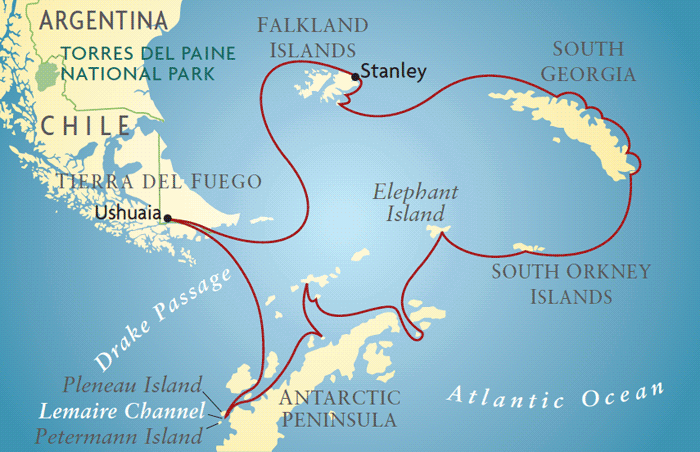 |
| The route of the Endurance. (https://alumni.stanford.edu/get/page/travel-study/trip/?ciid=23964) |
Page created on 5/24/2011 12:00:00 AM
Last edited 5/24/2011 12:00:00 AM
